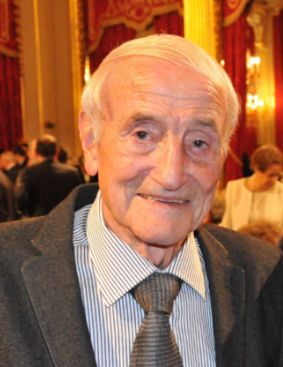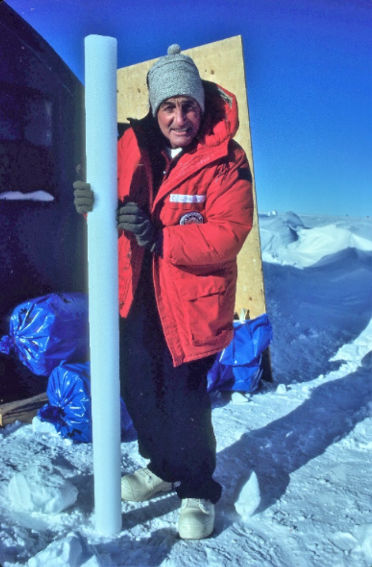 It is with deep sadness that SCAR has learnt of the recent death of Dr Claude Lorius, a pioneering glaciologist whose research helped to prove that mankind was responsible for global warming.
It is with deep sadness that SCAR has learnt of the recent death of Dr Claude Lorius, a pioneering glaciologist whose research helped to prove that mankind was responsible for global warming.
In 1955, responding to an advertisement on a bulletin board on the walls of the University of Besançon: “Needed: young researchers to join scientific excursions organized in conjunction with the International Geophysical Year”, Claude Lorius set off into the unknown polar regions, beginning with an expedition to Greenland and then wintering in Antarctica with two companions at Charcot Station, 2400 m up on the Polar Plateau. He lived there for two years.
It was on one of his later Antarctic expeditions in 1965 that he used gathered samples of old ice to chill his glass of whisky. Seeing bubbles burst as the ice cubes melted, he realized they could hold vital information about the composition of the atmosphere trapped in the ice, and so was born a key new area of palaeoclimatic research through the study of ice cores. He established a team of glaciologists at the Laboratoire de Glaciologie et Géophysique de l’Environnement (LGGE) in Grenoble to develop ice-core drilling equipment and techniques for dating and interpreting the ice sheet archives.
 Lorius was very active in SCAR’s Working Group on Glaciology during the 1960s and was instrumental in the group’s development of a new international programme (International Antarctic Glaciological Project (IAGP)) to investigate the ice between 90°E and 160°E, with an initial major objective of understanding the ice flow regime in order to interpret ice cores. Drilling began at Dome Concorde on the high plateau in the mid-1970s and, to everyone’s surprise, they found much lower CO2 and methane than today in glacial samples. By the 1980s, Lorius and his team were continuing their work in collaboration with the Soviets at Vostok Station. A series of major papers followed, establishing for the first time the way that temperature and CO2 had followed one another through glacial and interglacial periods.
Lorius was very active in SCAR’s Working Group on Glaciology during the 1960s and was instrumental in the group’s development of a new international programme (International Antarctic Glaciological Project (IAGP)) to investigate the ice between 90°E and 160°E, with an initial major objective of understanding the ice flow regime in order to interpret ice cores. Drilling began at Dome Concorde on the high plateau in the mid-1970s and, to everyone’s surprise, they found much lower CO2 and methane than today in glacial samples. By the 1980s, Lorius and his team were continuing their work in collaboration with the Soviets at Vostok Station. A series of major papers followed, establishing for the first time the way that temperature and CO2 had followed one another through glacial and interglacial periods.
Lorius served as SCAR Secretary from 1984 to 1986 and as SCAR President from 1986 to 1990. He held a number of roles at national level in France and led a number of French Polar Expeditions in the 1980s. Internationally he was a member of many organisations, including the World Climate Research Programme, Past Global Changes, the International Arctic Science Committee and the Greenland Ice Core Project, and he presided over the EPICA project (European Programme for Ice Coring in Antarctica) from 1993 to 1995.
He was awarded a number of prestigious international prizes and received the SCAR Medal for International Scientific Co-ordination in 2008. He was an officer of the Légion d’honneur (1998) and a foreign member of the Russian Academy of Science.
His achievements are towering and the Antarctic research community owes him a great debt. Our thoughts are with his family, friends and colleagues.
Memories of Claude Lorius from Peter Clarkson, Executive Secretary of SCAR from 1989 to 2005:
It was with great sadness that I learned Claude Lorius had died. While he was President of SCAR he interviewed me in 1988 for the position of Executive Secretary of SCAR in succession to George Hemmen. He gently took much of the heat out of my early days at SCAR which would otherwise have been, for me, a baptism of fire.
It was during his Presidency that the SCAR Working Group on Logistics was disbanded and the members re-established themselves as the Council of Managers of National Antarctic Programmes (COMNAP). The next few years were anxious times for SCAR as a new relationship between the scientists and the managers was gradually developed, particularly where the Delegate to SCAR and the Manager of the National Programme were one and the same person. Claude’s diplomacy during those early years helped to guide SCAR and COMNAP to the productive relationship they enjoy today.
As a scientist, Claude is renowned for recognizing that bubbles of air trapped in ancient polar ice could be analyzed to determine the atmospheric composition at the time the entrapping ice fell as snow. This was a major break-through in climate science which has shown that it is mankind’s industrial activity that is very largely responsible for climate change and global warming. This recognition has been of fundamental importance for our planet and is ultimately a debt of thanks that we all owe to Claude.
There was also a lighter, less-serious side to Claude’s character. It was traditional after the SCAR Banquet, towards the end of the Delegates’ Meeting, that there should be some musical entertainment, singing and dancing. For many years, Jim Zumberge, former President of SCAR from the USA, would produce his accordion to provide the music and Claude would take the microphone to sing. His style and appearance inevitably drew comparisons with the French night club singer Charles Aznavour, so much so that someone commented that if Claude ever failed as a scientist he could have a successful second career as a night club crooner!
I have fond memories of Claude, as a scientist, a diplomat for science, and as a sociable and entertaining companion. It has been a privilege for me to have known and worked with him.
